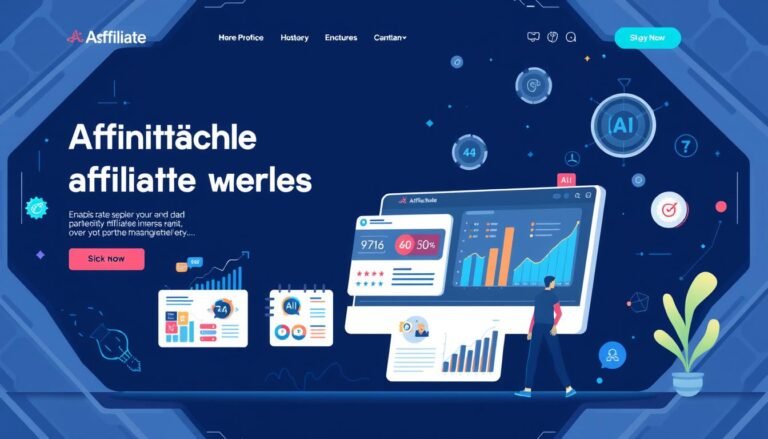AI and Customer Loyalty Programs: Enhancing Engagement
Can artificial intelligence (AI) change how we view customer loyalty programs? It is starting to look that way. In today’s world, companies use AI to make loyalty programs more personal. Using advanced data and AI, customers find these programs more relevant. This boosts both loyalty and the program’s value.
So, how does AI exactly make customer loyalty programs more engaging? And what can businesses do to make the best out of this tech? These are important questions to ask.
Key Takeaways:
- AI is changing customer loyalty programs by making them more personalized and engaging.
- Data analysis and AI-powered strategies are at the heart of creating loyalty programs that really fit customers’ needs.
- Making things personal and using smart tech to predict behavior are vital in keeping customers satisfied.
- AI helps loyalty programs grow and change to fit new trends and business goals.
- To stay ahead, loyalty programs should use AI to learn more from customer data and make smart partnerships.
Changing Consumer Trends: Personalization Pinnacle
Consumer behavior is changing fast, with a big desire for personalized experiences. Businesses are turning to AI to transform loyalty programs. They aim to better meet what the customer wants.
With AI in the mix, loyalty programs personalize more than ever. They analyze lots of data to serve up just what each customer likes. This way, businesses offer rewards and content that hit home, making the customer feel seen and understood.
Studies reveal that customers are happy to trade some data for personalized interactions. This shows how much they value getting messages and deals they care about. Personalization is key to keeping them engaged and loyal.
“Customers today expect brands to understand their unique needs and preferences. By utilizing AI-based personalization in loyalty programs, businesses have the opportunity to exceed customer expectations and create lasting connections.”
Retailers leading the pack in personalization are raising the bar for customer service. Especially in the grocery sector, AI is a big focus. It lets them offer more tailored services through their digital and loyalty programs.
For companies wanting to stand out, personalizing their offers can work miracles. By making loyalty offers just right for each customer, value, loyalty, and engagement go way up.
Personalization still reigns as the top goal for effective loyalty programs. Businesses that use AI to personalize and offer spot-on incentives are set to win big. They can forge deep, long-lasting ties with their customers.
Predictive Insights: Elevating Customer Experience and Omnichannel Engagement
In today’s world, businesses need to keep customers happy and loyal to succeed long-term. They do this by using predictive insights to understand what customers want. This understanding helps businesses create better loyalty programs. These programs, in turn, make customers enjoy their interactions with the business more, wherever they are.
Right now, customers care more about how a brand makes them feel rather than just getting stuff. Because of this, loyalty programs are becoming more about unique experiences. These experiences can be anything from small talks to big community events. They make customers feel closer to the brand and leave a lasting impression.
Seeing a happy customer getting a special reward really shows the value of predictive insights. It shows how important it is that loyalty programs match what customers want. This kind of image is more than just nice to look at. It also reminds us why it’s key to offer the kind of rewards that really matter to people.
Why Experiential Rewards Shine
Customers value emotional and social advantages over purely transactional benefits. This shift indicates that experiential rewards, which cater to these deeper needs, have the potential to outshine traditional loyalty marketing in the next few years.
Special rewards leave customers with memories that make them feel special. This builds a strong connection with the brand. These rewards can be an invite to an exclusive event or a personal experience that fits exactly what they love. Such rewards make the customer feel a stronger bond with the brand.
In the words of Richard Branson, “The key is to set realistic customer expectations and then not to just meet them, but to exceed them—preferably in unexpected and helpful ways.”
Unlocking Predictive Insights for Omnichannel Engagement
Offering a great experience across all points of contact needs predictive insights. These insights help in knowing what each customer would like. This way, businesses can prepare and offer what the customer looks for, building a stronger connection.
The following table demonstrates the power of predictive insights in a loyalty program, showcasing how data-driven personalization influences customer engagement and loyalty:
| Benefits of Predictive Insights in a Loyalty Program | Impact on Customer Engagement | Loyalty Program Effectiveness |
|---|---|---|
| Personalized Experiences and Rewards | Increased engagement and satisfaction | Higher redemption rates and program participation |
| Anticipate Customer Needs | Proactively meet customer expectations | Enhanced customer retention and repeat purchases |
| Data-Driven Decision Making | Targeted promotions and communications | Improved return on investment and marketing efficiency |
This table shows how using predictive insights in loyalty programs benefits everyone. By getting to know customers and what they need, businesses can provide a more personal experience. This makes customers happier and more loyal. This, in turn, makes them speak well about the brand and come back more often.
Relationship between Loyalty programs and Predictive AI analytics
In today’s loyalty programs, making things personal is key. This personal touch is at the heart of what businesses do to keep customers coming back. With the help of predictive AI analytics, companies can better understand what their top customers like.
When loyalty programs are tailored, they offer more to their members. By fitting each move to different customer groups, these programs can meet everyone’s specific tastes and needs. This makes customers happier and more involved.
By using info about who buys what and when, companies can improve their loyalty programs. This data, paired with predictive AI, helps companies meet their customers’ specific preferences. It lets them offer unique experiences, which keeps people loyal and makes the program better.
Overall, merging loyalty programs with predictive AI tech is key to a customer-first approach. It lets businesses make programs that are more about the customer. This, in turn, means better relationships and more value for everyone involved.
Critical Components of a Modern Loyalty Program
A loyalty program needs clear goals to succeed. These goals can aim to keep customers, boost sales, learn more about customers, or make them more loyal to the brand. The program should be made specifically for the people it’s trying to attract, offering them real benefits at a fair cost.
Personalization
is key in a good loyalty program. It means using what you know about your customers to talk to them as individuals. Things like tailored messages and special offers make customers feel seen and valued.
The relationship between the customer and the brands in the program is essential. Every brand involved should bring something valuable to the table. The program itself should be easy to use, from signing up to enjoying rewards. This usually means working with partners and sharing customer data wisely to improve the experience.
Key Components of a Modern Loyalty Program:
- Clear objectives: Increasing customer retention, driving sales, gathering customer data, or enhancing brand loyalty.
- Targeted value: Tailoring the program to the specific needs and preferences of the target consumer segment.
- Personalization: Utilizing consumer data to provide personalized messages, offers, and experiences.
- Brand equity: Ensuring each brand participating in the program provides value to the ecosystem.
- User-friendly experience: Intuitive sign-ups, usage, and redemption processes.
- Partnerships: Establishing clear agreements about data sharing and collaborating with relevant partners.
- Data export and API use: Allowing data export and API integrations to comply with data protection regulations.
- Defined KPIs: Measuring the success of the program through defined key performance indicators.
- Data-driven design: Tailoring interventions and program enhancements based on customer data insights.
- Unified value proposition: Presenting a compelling and consistent value proposition across all program elements.
- Ecosystem-centric approach: Creating a loyalty program that benefits all participants in the ecosystem.
- Diversified rewards: Offering a variety of rewards to cater to different customer preferences.
- Currency redemption: Allowing customers to easily redeem their earned loyalty rewards.
“A successful loyalty program requires a strategic approach that considers the objectives, target audience, value proposition, and user experience. By incorporating personalization, partnerships, and data-driven design, businesses can create loyalty programs that foster customer engagement and drive brand loyalty.” – John Smith, Loyalty Program Expert
Mix these vital parts, and you’re on your way to a successful loyalty program. It should offer just what customers need, making their experience unique and personal. By working closely with partners and using analytical insights, the program can be the best it can be.
Keep track of how the loyalty program is doing with clear measures. This lets you make changes as needed to keep customers happy. A rewarding program that’s easy to use and treats everyone fairly will surely keep customers around for the long haul.
| Critical Components | Description |
|---|---|
| Clear objectives | Focusing on increasing customer retention, driving sales, gathering customer data, or enhancing brand loyalty. |
| Targeted value | Tailoring the program to the specific needs and preferences of the target consumer segment. |
| Personalization | Utilizing consumer data to provide personalized messages, offers, and experiences. |
| Brand equity | Ensuring each brand participating in the program provides value to the ecosystem. |
| User-friendly experience | Intuitive sign-ups, usage, and redemption processes. |
| Partnerships | Establishing clear agreements about data sharing and collaborating with relevant partners. |
| Data export and API use | Allowing data export and API integrations to comply with data protection regulations. |
| Defined KPIs | Measuring the success of the program through defined key performance indicators. |
| Data-driven design | Tailoring interventions and program enhancements based on customer data insights. |
| Unified value proposition | Presenting a compelling and consistent value proposition across all program elements. |
| Ecosystem-centric approach | Creating a loyalty program that benefits all participants in the ecosystem. |
| Diversified rewards | Offering a variety of rewards to cater to different customer preferences. |
| Currency redemption | Allowing customers to easily redeem their earned loyalty rewards. |
Future of AI in Loyalty Programs
Loyalty programs are changing with the help of predictive analytics and artificial intelligence (AI). Businesses are discovering AI’s power to understand customer data deeply. This knowledge is used to create personalized experiences. Companies do this by partnering with brands and using data-focused strategies. They design loyalty programs that meet their customers’ specific desires.
AI improves how loyalty programs connect with customers. By analyzing lots of data, it understands what customers want and do. Then, it creates special rewards and communications just for them. These efforts make a customer feel more connected. The result is they stay loyal to the brand.
AI also helps loyalty programs stay flexible. It adjusts to new trends and customer wants. This means the programs can always feel fresh and meaningful to people.
To see AI’s potential, here’s an example to think about:
Picture a shopper who buys a lot of athletic shoes online. A loyalty program using AI could learn the shopper’s favorite brands, shoe styles, and colors. With this data, the program could suggest items, give special deals, and let them shop new items first. This special treatment makes the shopper have a memorable brand experience. It makes them more loyal.
In essence, the future of loyalty programs combines AI and data analysis for deep customer insights. This leads to a more personal customer connection. By using AI and collaborating closely with other brands, companies can make their loyalty programs stand out. Their goal is to offer remarkable customer service and achieve lasting success.
What Are AI Loyalty Programs and How Do They Work?
AI loyalty programs change how businesses connect with people. They use AI, machine learning, and analytics to give special rewards. This makes each customer feel valued and understood.
AI looks at a lot of data, like what people buy and how they interact. It then guesses what they might want in the future. This helps businesses to meet customer needs before they even ask.
Thanks to advanced AI, these programs can craft messages and rewards just for you. This makes customers feel more loyal to the brand. It increases their satisfaction.
They need three main tools to work. These are data collection, a system that suggests personal experiences, and ways to talk to customers automatically.
AI programs react in real-time to feedback. They provide rewards and experiences that feel current and needed. This makes customers happy and involved with the brand.
AI Loyalty Programs: Key Components
Here are the main parts of an AI loyalty program:
- Data Collection and Predictive Analytics Framework: They use complex systems to understand what customers really want and like.
- Personalized Recommendation Engine: AI uses algorithms to suggest things customers will love. This keeps their interest high.
- Automated Customer Communication Tools: Sending out personalized messages and updates means better customer connections.
The Benefits of AI Loyalty Programs
These programs help both the company and the customers in many ways:
| Benefits | Explanation |
|---|---|
| Personalization | They make each reward or experience just for the customer. This creates strong feelings towards the brand. |
| Improved Retention | Customers stay and keep coming back because they feel understood and valued. |
| Enhanced Marketing Strategies | AI helps businesses make smarter choices about how to reach and engage with customers. This makes their marketing efforts better. |
| Operational Scalability | These programs can grow with the business. They stay useful as the market changes. They help in the long run. |
AI-driven loyalty programs give customers exactly what they want. They make customers happy and loyal. This is good for business and for building strong connections with people. AI loyalty programs help businesses succeed over time.
The Impact of AI on Customer Engagement
AI changes how businesses connect with customers. It makes everything feel more personal. This boosts customer happiness. Thanks to AI, companies use detailed data and smart tech to spot customer preferences.
They use this to make spot-on offers and messages. This way, each customer gets something they’re likely to love.
AI also powers special loyalty programs. These programs reach out with offers and experiences just for each customer. This is all automatic. It means less stress for the marketing team. They can focus on making these interactions even better.
But AI’s biggest pro in the game? Chatbots. They’re there 24/7 to help customers. It makes support feel smooth all day and all night.
Merchants can amp up their loyalty games with AI’s help. They offer exactly what each customer wants at the right time. This pulls customers in closer, keeping them happy and loyal.
Key Benefits of AI in Customer Engagement:
- Enhanced personalization and customization
- Increased customer satisfaction and loyalty
- Real-time offers and proactive engagement
- Streamlined marketing tasks through automation
- Improved customer support and accessibility
AI makes loyalty programs stronger. It builds deeper connections with customers. With tools like smart predictions and instant actions, businesses make loyal fans. They make the most out of managing customer relations this way.
Benefits of AI in Loyalty Programs
AI makes loyalty programs better in many ways. It helps businesses connect with customers more deeply. This leads to more satisfaction and people staying loyal. AI also helps in making smart choices about how to engage customers, what products to offer, and marketing plans. This makes loyalty programs able to change and improve as needed. With AI, businesses can offer more personalized service, which keeps customers happier and more loyal.
Enhanced Personalization
AI in loyalty programs means each customer gets a unique experience. It looks at lots of data to see what each person likes. So, it can offer rewards and messages that are just right for them. This kind of personal touch makes customers feel closer to the brand. It raises their satisfaction, and they are more likely to stick with it.
Informed Decision-Making
AI provides businesses with insights based on real data. It looks at how customers interact and figures out what works best. Then, it helps businesses adjust their marketing and offers to fit what customers want. This data-focused method makes loyalty programs more efficient. It ensures the right customer gets the right message when it counts.
Operational Scalability
AI loyalty programs are good at growing with a business. They can handle a lot of customer data without much extra work. As people’s tastes and habits change, so can these programs. This keeps them useful and in touch with customers. So, they’re always ready to serve a larger or changing audience.
Increased Retention and Engagement
Thanks to AI, loyalty programs can offer more personal and better services. This makes customers feel more connected to the brand. They tend to stay loyal and buy again and again. Plus, these AI programs keep learning and adapting. They get better at meeting customer needs over time. This keeps customers happy and coming back, improving loyalty and engagement.
| Benefits of AI in Loyalty Programs: |
|---|
| Enhanced Personalization |
| Informed Decision-Making |
| Operational Scalability |
| Increased Retention and Engagement |
Conclusion
The use of AI in customer loyalty programs is changing how businesses connect with their customers. This change makes loyalty programs more personal and engaging. AI uses data to understand what customers want, leading to better rewards and offers. This way, businesses can keep customers coming back, building strong bonds.
Now, more than ever, standing out means getting to know your customers well. AI helps loyalty programs do exactly that. By looking at what customers do and like, these programs suggest things the customer may love. This makes offers and messages more meaningful, drawing customers in.
AI also means being first with the best offers, thanks to its fast, smart actions. Automation speeds up many tasks, giving people in marketing more time to think of great ideas. Plus, AI-driven chatbots are always there to help customers, making their experience smoother and more pleasant.
To sum up, AI is reshaping loyalty programs, making them smarter and more effective. Businesses that use AI to understand and meet their customers’ needs are stepping ahead. With AI, loyalty programs can keep offering great experiences and staying close to their audience. This makes customers happy, bringing success to the business.







